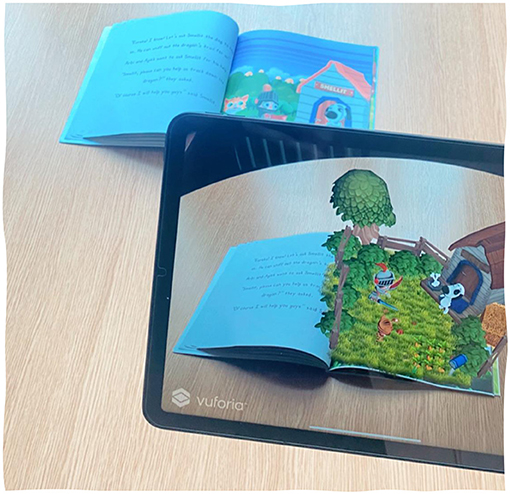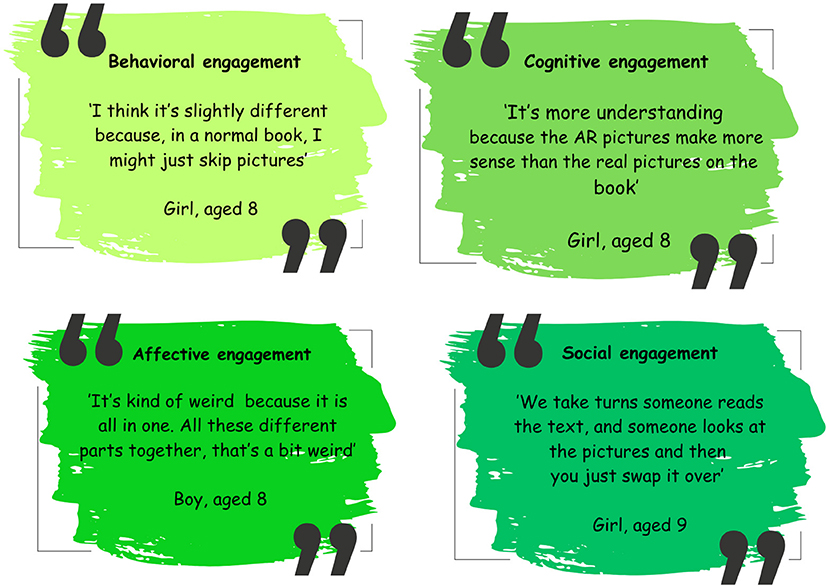Abstract
Augmented reality (AR) books provide a different way to read and engage with books. They look like any paper book you would usually read, but they have digitally added features such as 3D animations, questions, quizzes, and sounds that come alive on your digital device. Researchers are interested in whether AR books can help children better understand what they read. Opinions on AR books differ. While some children like the extra features in AR books, others say they prefer to use their own imaginations. Similarly, some parents think AR books could help with understanding, while others think they could distract children from reading. Researchers found that children who read an AR book did better at answering questions that required deep thinking compared to children who read the same story in a paper book. While AR books continue to evolve, this article looks at what researchers have discovered about AR books up to now.
Let Us Start!
If I ask you to think about different types of books, what would you think about? Fiction? Non-fiction? Graphic novels? Adventure stories? Comedy or fantasy? Or would you think about different book styles, such as paper, digital, audio, books with illustrations, or pop-up pictures? Our lives are full of many different types of books! But have you ever heard of augmented reality (AR) books—books that some people claim can make stories come to life? Over the last decade, new technologies have offered new ways to read and engage with books, and AR books are an exciting new development. AR books are traditional print books, but with special AR features that can be accessed via digital devices (e.g., iPads or smartphones). Researchers are just beginning to understand how AR books may reshape our reading experiences and influence our engagement and learning.
What Do AR Books Look Like?
AR books look like any paper book you would usually see. You can flip through the pages, look at images, and read the text. However, AR books also allow you to access additional features, such as 3D animations, sounds, and/or graphics related to the book. Those features are considered virtual objects, generated via a digital device that helps the book to come to life! Reading an AR book is simple—open the book, read the text, point your digital device at the printed page, and watch as virtual objects join you in the real world (Figure 1) [1]!

- Figure 1 - Example of an augmented reality book.
- By pointing your digital device at the page, the image can come to life.
What Do Parents Think About AR Books?
Researchers have recently begun to explore how parents feel about reading an AR book with their child and whether they would use AR books again in the future [2]. In this study, 47 parents were invited to read an AR book with their child (aged 4–9 years) for 20–30 minutes, and they were then asked to share their thoughts with the researcher. Of those parents, 35 liked how real the 3D images felt, and the sense of being completely involved in the book. In addition, parents were surprised that they could explore the AR book with typical electronic devices, and that they did not need to wear special AR glasses. However, others parents had more negative thoughts. For example, only 16 parents reported that they thought the AR book would help children understand and remember what they had read, and 12 parents thought the AR technology could distract their children from reading. Parents’ views about AR books, either positive or negative, could affect their decision to use them in the future. If your parents took part in this research, what would they think?
How Do AR Books Influence Children’s Reading Engagement?
We recently completed a study exploring children’s thoughts and experiences based on reading AR books. We specifically looked at children’s reading engagement, or how involved they were in the book [3]. Reading engagement has four aspects to it: behavioral (what we do), cognitive (how we think), affective (how we feel), and social (how we interact with others while reading) [4]. Behavioral engagement refers to our reading behaviors—how much time we spend reading, what we read, and how we read. Cognitive engagement refers to the mental effort we put into reading and the strategies we use to understand the text. Affective engagement refers to the feelings and emotions we experience while we read, while social engagement refers to taking part in reading activities with others [4].
In our study, we invited 38 children aged 8–10 with different levels of reading interest, experience, and ability to take part. Children read an AR book either by themselves or with a classmate, depending on their preference. Then we interviewed them about their reading experiences. From our interviews, we found that AR books changed aspects of all four types of engagement. Below are some quotes that we share as examples of children’s AR reading engagement:
Behavioral engagement: “I always read the text first, but today I read the picture first” (girl, age 9); “I read the text a bit faster and get the iPad and I point it to the pictures” (boy, age 8).
Cognitive engagement: “Pictures always help. Maybe if you are like, not understanding what is happening in the book or something, and then you just have a look at picture that can help, especially if the picture is kind of moving” (boy, age 8); “I would not say I would not understand it if I did not have a gadget, but I might understand it a bit more because it is 3D so I can actually see what is going on and how it actually happens” (girl, age 9).
Affective engagement: “It feels like amazing mixing with happiness into like one” (boy, age 8); “I actually liked when I picked the iPad up and put it in the picture actually, kind of enjoy reading that with some music” (girl, age 9).
Social engagement: “We like to share thoughts and then we share thoughts about what is funny and why that is funny, and then we laugh about it” (girl, age 8); “If I was just looking at it on my own, I would not find it as enjoyable” (boy, aged 8) (see Figure 2 for more examples of what children said).

- Figure 2 - Examples of children’s AR reading engagement.
However, while many children were positive about the AR books, others were not. For example, some felt that AR books did not allow them to use their own imaginations when reading, or that they were “a little bit of a waste of time” (boy, aged 9). Have you ever read an AR book? After hearing what other children have had to say, would you like to try one?
Do AR Books Influence Children’s Ability To Understand The Text?
One group of researchers conducted a study to examine whether AR books influence children’s ability to understand text [5]. In this study, two groups of students (aged 7–9) read the same book. In one group, the AR features were activated and students had an iPad to access these features. In the other group, only the printed book was read, and students did not have access to the AR features. After reading, students were asked to do two things: retell the story, and answer questions to measure their understanding.
Students were asked questions that required them to remember details (e.g., “in which direction did the boy ride the boat?”) and questions that required deeper thinking because the answer could not be found directly in the book (e.g., “How do you think the boy is feeling here?”). The researchers found that the group that read the book with AR features performed better when they were asked to retell the AR book’s story to someone who had never read the same book, and on questions that required deeper thinking. However, there was no difference in the quality of their answers to questions that required remembering details.
Of course, we cannot assume that all AR books will support readers’ ability to better understand what they read. For example, AR books vary in terms of the quality of their AR features [1], and AR books with higher-quality features that are more directly connected to the text may be better at supporting readers’ understanding.
Let Us Rap Things UP!
AR books are a new kind of book, and they can change our reading experiences. AR books blend the virtual world and the real world, by combining paper-based books with AR features, like sounds, 3D animations, and graphics. AR features can have a positive influence on our reading engagement and our ability to understand the text. There are lots of different AR books available (you can find them online and in some bookstores), with many different features and designs. Some are better than others. We hope that our research, and the work of other researchers, will influence AR book designers to create books that can better support children’s reading enjoyment, engagement, and understanding.
Glossary
Augmented Reality (AR) Book: ↑ A paper book with additional features, such as 3D animations, sounds, and/or graphics, which the reader can access by pointing the camera of a digital device to the printed page.
AR Features: ↑ Additional features such as 3D animations, sounds, and/or graphics related to the book. These features are activated by the AR technology.
Virtual Objects: ↑ Animated images, which are generated via computer. The objects do not exist in the real world, but they appear through the camera.
Behavioral Engagement: ↑ Our reading behaviors—how much time we spend reading, what we read, and how we read.
Cognitive Engagement: ↑ The mental effort we put into reading and the strategies we use to understand the text.
Affective Engagement: ↑ The feelings and emotions we experience while we read.
Social Engagement: ↑ Our involvement in reading activities with others.
Conflict of Interest
The authors declare that the research was conducted in the absence of any commercial or financial relationships that could be construed as a potential conflict of interest.
References
[1] ↑ Wang, R. 2022. Application of augmented reality technology in children’s picture books based on educational psychology. Front. Psychol. 13:782958. doi: 10.3389/fpsyg.2022.782958
[2] ↑ Cheng, K.-H. 2019. Parents’ user experiences of augmented reality book reading: perceptions, expectations, and intentions. Educ. Tech. Res. Dev. 67:303–315. doi: 10.1007/s11423-018-9611-0
[3] ↑ Alhamad, K., Manches, A., and McGeown, S. 2024. Augmented reality books: in-depth insights into children’s reading engagement. Front. Psychol. 15:1423163. doi: 10.3389/fpsyg.2024.1423163
[4] ↑ McGeown, S., and Smith, K. C. 2024. Reading engagement matters! a new scale to measure and support children’s engagement with books. Read. Teach. 77:462–472. doi: 10.1002/trtr.2267
[5] ↑ Danaei, D., Jamali, H. R., Mansourian, Y., and Rastegarpour, H. 2020. Comparing reading comprehension between children reading augmented reality and print storybooks. Comp. Educ. 153:103900. doi: 10.1016/j.compedu.2020.103900
